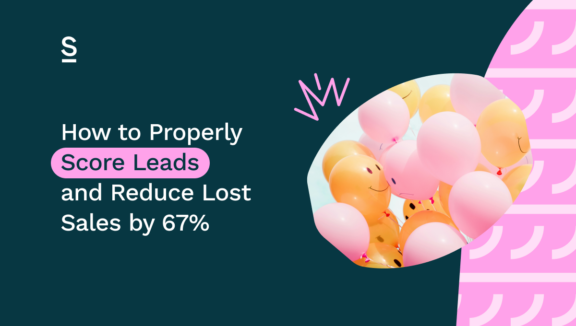The Power of Lead Scoring: How to Reduce Lost Sales by 67%

It’s every SDR’s dream. That every lead you touch is qualified and ready to be converted or moved to the next stage of the sales funnel. But to undertake the process of manually lead scoring every opportunity that comes your way would be an entire full-time job for one person. And which teams have the resource and budget for that.
But armed with the right tools, you can automate your lead scoring process to take away that burden, and make sure that every lead you touch is qualified and ready to be converted.
Keen to find out just how you can do that? Here’s what we’ll cover:
- What is a Sales Qualified Lead (SQL)?
- Why Lead Qualification Can Make or Break a Sale
- How Automating Follow-ups Boosts Your Conversion Rates
What is a Sales Qualified Lead (SQL)?
A Sales Qualified Lead (SQL) is a prospective customer who has shown a clear interest in your product or service and is ready to engage in the active outreach stages of the sales process.
SQLs start life just as any other general lead in your sales funnel: showing potential interest but without a defined intent to buy. As they engage more with your company’s content and offerings, they become Marketing Qualified Leads (MQLs), indicating a higher likelihood of purchasing if properly nurtured.
It’s when these MQLs demonstrate that they are ready to be sold to—evidenced by tell-tale signs like requesting demos or pricing information—that they are classified as SQLs.
Understanding this distinction is essential for effectively targeting your sales efforts and nurturing potential customers through the sales funnel, ensuring that you focus your resources on those who are most prepared to make a purchase.
Why lead qualification can make or break a sale
If you don’t qualify your leads, how do you know they are ready to purchase from you?
Increased efficiency
Rather than wasting time on emails that will go unread and calls that will only go to voicemail, qualifying leads allows sales teams to prioritize their efforts on prospects that are more likely to convert into paying customers.
So you can allocate time, resource and budget on leads that match the business’s target market and have a genuine interest or need for the product or service.
Increased conversion rates
Qualified leads are those prospects that have been assessed and meet pre-defined criteria as being the most likely to convert. This assessment hinges upon your prospects’ pain points — i.e. the business challenge they are trying to solve at any given moment, their budget, and the timing of the sales outreach. Engaging with these leads has a better chance of converting because there is a real need for the solution you’re selling. And it’s the right time for them to buy, and they have the cash to commit.
Building better customer relationships
When you focus on qualified leads, you can hone your sales outreach with a laser focus to meet the specific pain points of your prospects, and offer solutions in the form of your product or service. This personalized approach improves the customer experience, increases satisfaction, and can lead to stronger customer relationships and loyalty: ultimately, it increases deal conversion (by a whopping 30%).
How to Automate Your Lead Scoring
Decide on lead scoring criteria
To qualify leads, it’s important to have a lead-scoring process in place. This means that you award points to your leads when they meet certain criteria or conditions. You also set a threshold that signals the lead is qualified. You might begin by awarding points based on conditions like the lead’s location, role, and company size. Then these leads have the opportunity to earn more points when they interact with your content.
Over time, the more engagement and interest they show in your product or service, the more points they will earn according to your lead scoring system. So, if you set your lead scoring threshold to 100, this means that when a lead reaches 100 points, they are sales-qualified and ready for your sales team to pursue.
Set up lead-scoring properties in your CRM
Every CRM has its own way of setting up a lead scoring process, so you must set up your CRM accordingly. But, we’ve set up some handy how-to guides to get you started:
- How to set up lead scoring properties in HubSpot
- How to set up lead scoring in Salesforce with Einstein
- Setting up a lead scoring process with Pipedrive
- How to set up lead scoring with Copper
On most CRMs, setting up your lead scoring process usually means assigning how many points will be gained based on different properties. Let’s take company size as an example. If, in your lead scoring criteria, a lead earns 5 points when their company size is more than 500 people, you would assign the score to the company size property.
If {company size} = 500+ then + 5 points
Another example would be based on actions, such as web visits. If you have a contact property in your CRM for ‘number of sessions’, you might want to assign 10 points if they have visited your website more than 5 times.
If {number of sessions} = 5+ then + 10 points
Time to Prospect
Now that your lead scoring process is set up in your CRM, it’s time to start prospecting leads so you can score them. Keen to increase your efficiency even further? Add leads to your CRM that you know are likely to already earn a significant lead score based on your lead scoring criteria.
Let’s imagine your lead scoring process assigns points to leads who work in sales, in companies of more than 500 people that are based in Paris, who have been in their role for more than 3 years, and operate in the finance industry.
You can use LinkedIn’s Sales Navigator to search for exactly this criteria.
This particular search still results in more than 4,000 potential leads, so you might want to refine your search even further. Now it’s time to add them to your CRM.
To ensure your lead scoring criteria can work as efficiently as possible, you’re going to want to add as much information about these leads to your CRM as possible. But that’s a lot of manual data entry, and time that you just don’t have, right?
Enter, Surfe
Surfe allows you to add LinkedIn contacts to your CRM in one-click. It automatically transfers all of data that is available from their LinkedIn profile to the relevant CRM properties, ready for scoring.
Even better, you can export whole lists of leads from Sales Navigator to your CRM using Surfe. What once took hours now only takes a matter of minutes, saving up to 13 hours per week for you to focus on selling.
Automate follow-ups
When your leads are in your CRM, they should now have a good qualification score based on your new scoring criteria. But now is time for them to start earning more points so they can become sales qualified.
But this doesn’t happen by magic (an SDR can dream, hey?).
Instead, you need to guide your leads through the sales funnel with targeted and personalized outreach so they can earn more lead scoring points along the journey.
Best practices for qualifying leads with automated workflows
Automated workflows are unique from company to company and campaign to campaign, but it’s important that you’re sending the right message, to the right contact, at the right time. When creating your workflow, you’ll need to define clear triggers that will initiate an automated follow-up. Triggers can be based on various activities or milestones, such as:
Lead Scoring Thresholds: When a lead accumulates enough points to indicate strong interest or fit.
Behavioral Triggers: Specific actions taken by the lead, like visiting a pricing page, downloading an ebook, or engaging with previous emails.
Event-Based Triggers: Attendance of webinars, conferences, or other events that your company hosts or participates in.
Time-Based Triggers: Follow-up after a certain period has elapsed since the last interaction, ensuring leads remain engaged.
There are several types of automated workflows you can implement, each serving a different purpose in the lead nurturing process:
Educational Workflows: Provide valuable content and insights to help leads solve problems and recognize the value of your solutions.
Engagement Workflows: Designed to encourage interaction with your brand through surveys, feedback requests, or social media engagement prompts.
Re-engagement Workflows: Target leads that have gone cold, aiming to reignite interest with compelling offers or content.
Conversion Workflows: Push leads towards taking a decisive action, such as signing up for a demo or consultation.
Personalizing your automated workflows
Your prospects don’t want to feel as though they are receiving generic sales communications. Use the lead’s name, reference their company, and tailor the content of your email based on their interests and previous interactions. Advanced CRM systems can automate this personalization at scale. But personalization doesn’t stop at addressing them by name. Use segmentation to personalize the experience.
Segmentation means grouping leads based on similar behaviors, interests, or demographic characteristics. For example, you might segment all of the contacts who clicked the link in your previous email into a group. Then, in the next email in your workflow, send this group different content to those who didn’t click the link. After all, this group of leads are likely more qualified since they are engaging with your content.
The Right Automation Tools and Technologies
Most CRM platforms offer automation features and you can use tools like Surfe to add LinkedIn contacts directly to a workflow. To use Surfe to add LinkedIn contacts to a workflow directly from their profile, simply set a trigger for enrolment into the workflow as being a member of a specific list.
Surfe can be used to show specific CRM properties on LinkedIn profiles. You can use one of these fields for list membership. Simply enter the name of your desired list into this field. Surfe will add the contact to your list, which will in turn enrol them into your automated workflow.
How Automating Follow-ups Boosts Your Conversion Rates
Marketing automation is hot on business leaders lips. But to form a proper automation strategy, you need to consider the criteria and conditions you set that triggers outreach to be sent to your prospects. These criteria and conditions will vary from business to business but can be based on time, actions, or simply the demographic of the lead. But the evidence speaks for itself. Here’s how automation can supercharge your sales funnel:
Increased number of qualified leads
Implementing marketing automation for nurturing leads can lead to a 451% boost in qualified leads. Yep, you read that right. For some sales teams, this means an endless pool of potential customers to prospect from.
Segmentation and personalization
By segmenting leads based on behavior and engagement, automated follow-ups can deliver more relevant content. Did a lead view your pricing page several times? Attend a webinar? Download some gated content? Send them something targeted and give them a chance to travel further along the sales funnel.
Strike while the iron is hot
Quick and relevant responses to lead actions keep your brand at the forefront of your prospects’ minds. Automation ensures that no opportunity for engagement is missed, making leads feel valued and more likely to convert.
Push to a demo
When your leads are qualified, it’s time to push them towards a demo. How you do this will depend on the size of your company, the nature of your business, and the number of qualified leads that you have.
If you have a lot of qualified leads and your ACV is relatively low, you may decide to automate this step. This can be an extension of the previous step – you would have a workflow that is triggered by a lead reaching ‘qualified’ status and you then send them an engaging and personalized email that pushes them towards a demo.
Lead disqualification
Equally important to qualifying leads is knowing when to disqualify them. Not every prospect is a good fit for your product or service, and recognizing this early saves resources.
Disqualification criteria might include a lack of budget, no decision-making authority, or a timeline that doesn’t align with your sales cycle. You might choose to deduct points based on a lack of engagement with your content or you might choose to remove a lead from the qualification process altogether if they haven’t shown any buying intent after a specific time period.
Let’s Wrap it Up!
Qualifying leads can be the difference between a successful sales team and a struggling one. And while it can seem like a daunting task to manually qualify all your leads, there are a number of automation tools on the market that make lead qualification a breeze.
Take the time to consistently re-evaluate your lead scoring criteria, so you know that the leads you’re prospecting are those most likely to convert. And tailor your outreach at every sales touch to improve the chances of converting your leads.

Ready to save 13 admin hours EVERY week?
With Surfe you can automatically sync the details, contact information, and conversations you have on LinkedIn to your CRM in just one click.
Frequently Asked Questions (FAQs)
What is a Sales Qualified Lead (SQL)
A Sales Qualified Lead is someone who has shown clear signs they are ready to buy from your business.
What is the difference between a Marketing Qualified Lead (MQL) and a Sales Qualified Lead (SQL)?
A Marketing Qualified Lead is someone who has shown interest in your content or marketing activity, while a Sales Qualified Lead is someone who has shown intent to buy from you and is ready to enter the late stages of the sales funnel.
Why should I use lead scoring in sales?
Lead scoring can drastically improve your conversion rates by saving you time on outreach to prospects that just aren’t ready to commit to making a purchase.


